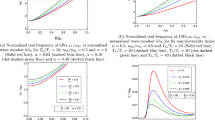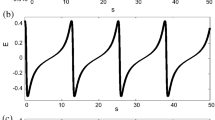Abstract
Electrostatic (ES) waves generated in space plasmas, e.g., Langmuir and ion-acoustic waves, are subject to multiple applications, such as plasma diagnosis, generation of radio emissions, and the acceleration and heating of resonant populations. The dispersion properties of these waves are well known for idealized plasmas, i.e., with Maxwellian distributions, but in the solar wind and terrestrial magnetosphere plasma particles exhibit Kappa distributions with high energy tails enhanced by suprathermal populations. This paper proposes a realistic analysis of these populations and their influence on ES waves, which often is hindered by a misinterpretation of Kappa distributions. Of particular importance in the analysis of ES waves is the Debye wavelength, the correct derivation of which shows, as expected, an increase (and not a decrease) in the presence of suprathermal electrons. Based on these new evaluations, we show how the suprathermal electrons self-consistently modify the properties of ES waves. For Langmuir waves, the positive slope of the frequency increase with the wave-number is markedly enhanced, involving more resonant particles from the high-energy tails, and thus leading to enhanced damping rates. In contrast, ion-acoustic waves are supported by suprathermal electrons, which increase the kinetic energy contrast between electrons and protons, and thus reduce the damping rate of ion-acoustic waves. Obviously, suprathermal protons do not affect Langmuir waves, but inhibit ion-acoustic modes. The present results provide both the methodology and the theoretical tools necessary to understand the physical processes involving these waves in non-ideal plasmas from space.




Similar content being viewed by others
Data Availability
The data that support the findings of this study are available from the corresponding author upon a reasonable request.
Notes
We must point out, especially for readers less familiar with these models, that Kappa distributions have also received an alternative interpretation, described briefly in Appendix A, and to more detail in Lazar et al. (2015) and Lazar et al. (2016). This modified (and simplistic) Kappa approach is sometimes preferred in theoretical modeling, but cannot describe suprathermal populations and their effects on plasma waves and instabilities (Lazar and Fichtner 2021).
References
Briand, C.: Nonlinear Process. Geophys. 16(2), 319 (2009). https://doi.org/10.5194/npg-16-319-2009
Briand, C., Henri, P., Génot, V., Lormant, N., Dufourg, N., Cecconi, B., Nguyen, Q.N., Goetz, K.: J. Geophys. Res. Space Phys. 121(2), 1062 (2016). https://doi.org/10.1002/2015JA022036
Bryant, D.A.: J. Plasma Phys. 56(1), 87 (1996). https://doi.org/10.1017/S0022377800019115
Chateau, Y., Meyer-Vernet, N.: J. Geophys. Res. Space Phys. 96, 5825 (1991). https://doi.org/10.1029/90JA02565
Fahr, H.J., Heyl, M.: Astron. Astrophys. 589, 85 (2016). https://doi.org/10.1051/0004-6361/201628082
Fried, B.D., Conte, S.D.: The Plasma Dispersion Function. Academic Press, New York (1961)
Fuselier, S.A., Gary, P.S., Thomsen, M.F., Bame, S.J., Gurnett, D.A.: J. Geophys. Res. 92(A5), 4740 (1987). https://doi.org/10.1029/JA092iA05p04740
Ganse, U., Kilian, P., Spanier, F., Vainio, R.: Astrophys. J. 751(2), 145 (2012). https://doi.org/10.1088/0004-637x/751/2/145
Gary, S.P.: Theory of Space Plasma Microinstabilities. Cambridge University Press, Cambridge (1993)
Graham, D.B., Khotyaintsev, Y.V., Vaivads, A., Edberg, N.J.T., Eriksson, A.I., Johansson, E.P.G., Sorriso-Valvo, L., Maksimovic, M., Souček, J., Píša, D., Bale, S.D., Chust, T., Kretzschmar, M., Krasnoselskikh, V., Lorfèvre, E., Plettemeier, D., Steller, M., Štverák, Š., Trávníček, P., Vecchio, A., Horbury, T.S., O’Brien, H., Evans, V., Angelini, V.: Astron. Astrophys. 656, 23 (2021). https://doi.org/10.1051/0004-6361/202140943
Gurnett, D.A., Anderson, R.R.: J. Geophys. Res. 82(4), 632 (1977). https://doi.org/10.1029/JA082i004p00632
Gurnett, D.A., Frank, L.A.: J. Geophys. Res. 83(A1), 58 (1978). https://doi.org/10.1029/JA083iA01p00058
Hess, R.A., MacDowall, R.J., Goldstein, B., Neugebauer, M., Forsyth, R.J.: J. Geophys. Res. 103(A4), 6531 (1998). https://doi.org/10.1029/97JA03395
Kasper, J.C., Lazarus, A.J., Gary, S.P., Szabo, A.: In: Velli, M., Bruno, R., Malara, F., Bucci, B. (eds.) Solar Wind Ten. American Institute of Physics Conference Series, vol. 679, p. 538 (2003). https://doi.org/10.1063/1.1618653
Kellogg, P.J.: Astrophys. J. 891(1), 51 (2020). https://doi.org/10.3847/1538-4357/ab7003
Kim, S., Yoon, P.H., Choe, G.S., moon, Y.-J.: Astrophys. J. 828(1), 60 (2016). https://doi.org/10.3847/0004-637x/828/1/60
Krasnoselskikh, V.V., Dudok de Wit, T., Bale, S.D.: Ann. Geophys. 29(3), 613 (2011). https://doi.org/10.5194/angeo-29-613-2011
Kurth, W.S., Gurnett, D.A., Scarf, F.L.: J. Geophys. Res. Space Phys. 84(A7), 3413 (1979). https://doi.org/10.1029/JA084iA07p03413
Lazar, M.: Phys. Plasmas 24(3), 034501 (2017). https://doi.org/10.1063/1.4977899
Lazar, M., Fichtner, H. (eds.): Kappa Distributions: From Observational Evidences via Controversial Predictions to a Consistent Theory of Non-equilibrium Plasmas. Springer, Berlin (2021)
Lazar, M., Poedts, S., Fichtner, H.: Astron. Astrophys. 582, 124 (2015). https://doi.org/10.1051/0004-6361/201526509
Lazar, M., Fichtner, H., Yoon, P.H.: Astron. Astrophys. 589, 39 (2016). https://doi.org/10.1051/0004-6361/201527593
Lazar, M., López, R.A., Shaaban, S.M., Poedts, S., Fichtner, H.: Astrophys. Space Sci. Trans. 364(10), 171 (2019). https://doi.org/10.1007/s10509-019-3661-6
Lazar, M., Pierrard, V., Poedts, S., Fichtner, H.: Astron. Astrophys. 642, 130 (2020). https://doi.org/10.1051/0004-6361/202038830
Lazar, M., López, R.A., Shaaban, S.M., Poedts, S., Yoon, P.H., Fichtner, H.: Front. Astron. Space Sci. 8, 249 (2022). https://doi.org/10.3389/fspas.2021.777559
López, R.A., Lazar, M., Shaaban, S.M., Poedts, S., Moya, P.S.: Astrophys. J. Lett. 900(2), 25 (2020). https://doi.org/10.3847/2041-8213/abaf56
MacDowall, R.J., Lin, N., McComas, D.J.: Space Sci. Rev. 97, 141 (2001). https://doi.org/10.1023/A:1011846700852
Mace, R.L., Hellberg, M.A.: Phys. Plasmas 2(6), 2098 (1995). https://doi.org/10.1063/1.871296
Maksimovic, M., Gary, S.P., Skoug, R.M.: J. Geophys. Res. 105(A8), 18337 (2000). https://doi.org/10.1029/2000JA900039
Maksimovic, M., Zouganelis, I., Chaufray, J.-Y., Issautier, K., Scime, E.E., Littleton, J.E., Marsch, E., McComas, D.J., Salem, C., Lin, R.P., Elliott, H.: J. Geophys. Res. Space Phys. 110, 09104 (2005). https://doi.org/10.1029/2005JA011119
Mangeney, A., Salem, C., Lacombe, C., Bougeret, J.-L., Perche, C., Manning, R., Kellogg, P.J., Goetz, K., Monson, S.J., Bosqued, J.-M.: Ann. Geophys. 17(3), 307 (1999). https://doi.org/10.1007/s00585-999-0307-y
Meyer-Vernet, N., Issautier, K., Moncuquet, M.: J. Geophys. Res. Space Phys. 122(8), 7925 (2017). https://doi.org/10.1002/2017JA024449
Olbert, S.: In: Carovillano, R.D.L., McClay, J.F. (eds.) Physics of the Magnetosphere. Astrophys. Space Sci. Library, vol. 10, p. 641 (1968)
Pierrard, V., Lazar, M., Poedts, S., Štverák, Š., Maksimovic, M., Trávníček, P.M.: Sol. Phys. 291(7), 2165 (2016). https://doi.org/10.1007/s11207-016-0961-7
Píša, D., Souček, J., Santolík, O., Hanzelka, M., Nicolaou, G., Maksimovic, M., Bale, S.D., Chust, T., Khotyaintsev, Y., Krasnoselskikh, V., Kretzschmar, M., Lorfèvre, E., Plettemeier, D., Steller, M., Štverák, Š., Trávníček, P., Vaivads, A., Vecchio, A., Horbury, T., O’Brien, H., Evans, V., Angelini, V., Owen, C.J., Louarn, P.: Astron. Astrophys. 656, 14 (2021). https://doi.org/10.1051/0004-6361/202140928
Podesta, J.J.: Phys. Plasmas 12(5), 052101 (2005). https://doi.org/10.1063/1.1885474
Pulupa, M.P., Bale, S.D., Kasper, J.C.: J. Geophys. Res. Space Phys. 115(A4), 04106 (2010). https://doi.org/10.1029/2009JA014680
Schlickeiser, R.: Cosmic Ray Astrophysics. Springer, Berlin (2002)
Shaaban, S.M., Lazar, M., López, R.A., Fichtner, H., Poedts, S.: Mon. Not. R. Astron. Soc. 483(4), 5642 (2019). https://doi.org/10.1093/mnras/sty3377
Štverák, Š., Trávníček, P., Maksimovic, M., Marsch, E., Fazakerley, A.N., Scime, E.E.: J. Geophys. Res. Space Phys. 113(A3), 03103 (2008). https://doi.org/10.1029/2007JA012733
Summers, D., Thorne, R.M.: Phys. Fluids B 3(8), 1835 (1991). https://doi.org/10.1063/1.859653
Tao, J., Wang, L., Zong, Q., Li, G., Salem, C.S., Wimmer-Schweingruber, R.F., He, J., Tu, C., Bale, S.D.: Astrophys. J. 820(1), 22 (2016). https://doi.org/10.3847/0004-637x/820/1/22
Thejappa, G., MacDowall, R.J., Scime, E.E., Littleton, J.E.: J. Geophys. Res. Space Phys. 108(A3), 1139 (2003). https://doi.org/10.1029/2002JA009290
Thorne, R.M., Summers, D.: Phys. Fluids B 3(8), 2117 (1991). https://doi.org/10.1063/1.859624
Treumann, R.A., Jaroschek, C.H., Scholer, M.: Phys. Plasmas 11(4), 1317 (2004). https://doi.org/10.1063/1.1667498
Vasyliunas, V.M.: J. Geophys. Res. 73, 2839 (1968). https://doi.org/10.1029/JA073i009p02839
Vocks, C., Salem, C., Lin, R.P., Mann, G.: Astrophys. J. 627(1), 540 (2005). https://doi.org/10.1086/430119
Willes, A.J., Cairns, I.H.: Phys. Plasmas 7(8), 3167 (2000). https://doi.org/10.1063/1.874180
Wilson, L.B., Chen, L.-J., Wang, S., Schwartz, S.J., Turner, D.L., Stevens, M.L., Kasper, J.C., Osmane, A., Caprioli, D., Bale, S.D., Pulupa, M.P., Salem, C.S., Goodrich, K.A.: Astron. Astrophys. Suppl. Ser. 245(2), 24 (2019). https://doi.org/10.3847/1538-4365/ab5445
Yang, L., Wang, L., Zhao, L., Tao, J., Li, G., Wimmer–Schweingruber, R.F., He, J., Tian, H., Bale, S.D.: Astrophys. J. Lett. 896(1), 5 (2020). https://doi.org/10.3847/2041-8213/ab9531
Yoon, P.H., Ziebell, L.F., Gaelzer, R., Lin, R.P., Wang, L.: Space Sci. Rev. 173(1-4), 459 (2012). https://doi.org/10.1007/s11214-012-9867-3
Yoon, P.H., Kim, S., Choe, G.S.: Astrophys. J. 812(2), 169 (2015). https://doi.org/10.1088/0004-637x/812/2/169
Acknowledgements
The authors acknowledge support from the Mansoura University, Katholieke Universiteit Leuven, and Ruhr-University Bochum. RAL acknowledges the support of ANID Chile through FONDECyT grant No. 11201048.
Funding
These results were obtained in the framework of the projects C14/19/089 (C1 project Internal Funds KU Leuven), G.0D07.19N (FWO-Vlaanderen), SIDC Data Exploitation (ESA Prodex-12), and Belspo project B2/191/P1/SWiM.
Author information
Authors and Affiliations
Contributions
All authors listed have made a substantial, direct, and intellectual contribution to the work and approved it for submission.
Corresponding author
Ethics declarations
Conflict of Interest
None.
Competing interests
The authors declare no competing interests.
Additional information
Publisher’s Note
Springer Nature remains neutral with regard to jurisdictional claims in published maps and institutional affiliations.
Appendix: Kappa model with \(\kappa \)-independent temperature
Appendix: Kappa model with \(\kappa \)-independent temperature
By contrast to the original Kappa distribution from (1), in the literature we can also find another Kappa approach with temperature (also defined by the second order moment) independent of \(\kappa \) parameter (Bryant 1996; Podesta 2005)
whose relevance is still disputable (Lazar et al. 2015, 2016). In this case the Maxwellian limit takes the same form as in (2)
However, the Debye length for Kappa electrons changes as follows
where \(\lambda _{D,{\mathrm{M}}} = [m_{e} \theta ^{2} /(8 \pi n e^{2})]^{1/2}\) is obviously the same.
A graphical comparison of the Debye lengths ratios \(\lambda _{D,\kappa}/\lambda _{D,{\mathrm{M}}}\), as given by Eqs. (4) (red) and (24) (black-dotted), is provided in Fig. 5. The relevant one (red) shows a natural lowering of \(\lambda _{D,\kappa}\) with increasing the power-exponent \(\kappa \), due to the decrease of the mean kinetic energy or temperature of electrons. For low values of \(\kappa \to 3/2\), the Debye length is, however, not much superior and remains comparable to the Maxwellian limit of the core, i.e., that obtained in the absence of suprathermals.
For the other Kappa model with \(\kappa \)-independent temperature, the variation of the Debye length reduces to very small values with decreasing \(\kappa \to 3/2\). This results is not only contradictory, but even unphysical, because the mean kinetic energy or temperature of electrons does not change.
Rights and permissions
Springer Nature or its licensor holds exclusive rights to this article under a publishing agreement with the author(s) or other rightsholder(s); author self-archiving of the accepted manuscript version of this article is solely governed by the terms of such publishing agreement and applicable law.
About this article
Cite this article
Lazar, M., Shaaban, S.M., López, R.A. et al. About the effects of solar wind suprathermal electrons on electrostatic waves. Astrophys Space Sci 367, 104 (2022). https://doi.org/10.1007/s10509-022-04116-8
Received:
Accepted:
Published:
DOI: https://doi.org/10.1007/s10509-022-04116-8





